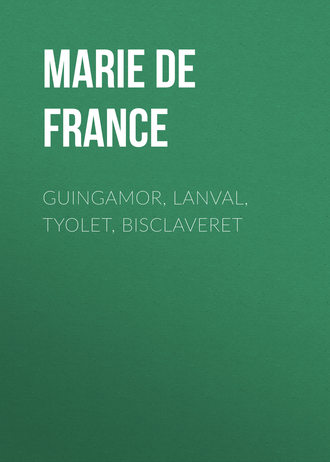 полная версия
полная версияGuingamor, Lanval, Tyolet, Bisclaveret
The original tale at the root of the Cerf au pied blanc was, I believe, a transformation tale; the stag was the enchanted relative of the lady who instigated the adventure, and the spell could only be broken by smiting off the animal's foot (as in many instances it is necessary to cut off the head of the victim of magic spells); this seems to me the only explanation of what is here a pointless act of cruelty. Probably the connecting link with the tale of Tyolet is the mysterious stag-knight of the first part, not the fairy gift of whistling as M. Gaston Paris suggested. I believe the story to be the origin of the white stag guarded by six lions in the Prose Lancelot, which in the "Queste" changes with its four attendant lions into Our Lord and the Four Evangelists. The real meaning of the story has here been preserved. This solution is also indicated by the fact that one of the shapes assumed by Merlin in his numerous transformations is that of a stag with one white foot (cf. "Merlin," Sommer's edition, xxiii. p. 302).
In connection with this it may be noted that a story published in the Scottish Celtic Review, vol. i., "Macphie's Black Dog," contains a striking parallel to Tyolet. The hero goes forth to shoot and sees a royal stag, but whenever he raises his gun to fire the animal changes into a woman. I think it is clear that in Tyolet we have the Perceval Enfances plus a transformation tale.
THE WERE-WOLFThe source of this is the Lai du Bisclavaret, by Marie de France. She was evidently relating a popular tradition, and there can be little doubt that it is the story referred to by Malory in the passage quoted at the heading of the tale. In Marie's Lai none of the characters are named.
The same story appears to be at the root of a Celtic folk-tale, Morraha, published by Mr. Jacobs in his collection entitled, "More Celtic Fairy Tales," here, however, being only subsidiary, a story within a story. Elsewhere I have found no trace of it, but the reference in Malory appeared to justify its inclusion among Arthurian tales.
Since writing this note Mr. Nutt has drawn my attention to a tale published in the Scottish Celtic Review, referred to above, "How the Great Tuairisgeul was put to Death." This tale strongly resembles Morraha, only the transformation is brought about by the spells of a witch employed by the stepmother, and is not the deed of the wife. Morraha seems to occupy a position between our tale and this. It may be suggested that there is a certain resemblance between the name Morraha, and that given by Malory for the hero of the story Marrok. It is worth noting that in both these tales the sympathy of the reader is invited for the wolf. As a rule a were-wolf is an object of dread and abhorrence.
1
In this connection, cf. Mr. Nutt's "Fairy Mythology of Shakespeare" – Popular Studies, No. 6.
2
Cf. Dr. Schofield's studies of the lais of Guingamor, Graalent, and Lanval, referred to in the Notes.
3
To this rule Nimue, = the Lady of the Lake, appears to be the only exception.

